- 1Wuxi Research Institute of Petroleum Geology, Petroleum Exploration and Production Research Institute, SINOPEC, Wuxi, China
- 2State Key Laboratory of Shale Oil and Gas Enrichment Mechanisms and Effective Development, SINOPEC, Beijing, China
- 3Petroleum Exploration and Production Research Institute, SINOPEC, Beijing, China
- 4Exploration and Production Research Institute, Zhongyuan Oilfield Branch, SINOPEC, Zhengzhou, China
The Dongpu Sag is one of the important areas for oil and gas exploration in the Bohai Bay Basin, eastern China, and natural gas from different strata in the sag contain a certain amount of helium, with the geochemical characteristics and the implications being weakly studied. Based on the analyses of the helium contents and isotopic ratios (3He/4He, 40Ar/36Ar, CH4/3He, and CO2/3He) of natural gas, the abundance and origin of helium as well as the correlation with CH4 and CO2 are investigated. The results indicate that, natural gas samples from the Dongpu Sag display the helium contents of 0.0031–0.0217% and 3He/4He ratios of 0.148 × 10−7–11.986 × 10–7, and the CH4/3He and CO2/3He ratios range from 3.7 × 109 to 1.8263 × 1012 and from 0.05×109 to 35.04 × 109, respectively. Natural gas in the sag is helium depleted and extremely depleted, with the average helium content of 0.0133%. The helium reserves in the total gas reserves are 18.38 × 106 m3, meeting the standard of small helium gas field. The helium is mainly crustal which has been mixed by a small amount of mantle-derived helium, whose proportion ranges from 0.01% to 10.72% with an average of 2.39%. Helium-related isotopic ratios of natural gas from the Dongpu Sag are consistent with those from other areas of the Bohai Bay Basin, suggesting crust-mantle mixed sources. Several gas samples from members 2 and 3 of the Shahejie Fm. contain an insignificant amount of mantle-derived helium, displaying the characteristics consistent with natural gas from typical cratonic basins.
Introduction
Geochemical characteristics of natural gas are fundamental to reveal the origin, source, and alteration processes of natural gas (Wu et al., 2017; Gong et al., 2018, Gong et al., 2019; Liu et al., 2019). As a noble gas with strategic values, helium has played an unreplaceable role in the high-tech fields considering the unique physicochemical properties (Xu et al., 1998; Anderson, 2018). Global helium demand increases by 4%–6% annually (Zhao et al., 2012), and it exceeds the supply for a long time. The discovered helium resources in the world are mainly concentrated in the U.S., Qatar, Algeria, and Russia, and their resources account for over 90% of the global resources (Anderson, 2018). Helium resource in China is relatively scarce, and the helium supply basically rely on imports (Tao et al., 2019; Chen et al., 2021; Peng et al., 2022). Helium is weakly explored in China, which demands further evaluation of helium resources and reserves. Since the helium content in the atmosphere is as low as 5.24 × 10–6 (Porcelli et al., 2002), helium extraction from helium-bearing natural gas is the only approach to industrially produce helium (Anderson, 2018; Tao et al., 2019; Chen et al., 2021).
Helium in natural gas includes three types, i.e., atmospheric helium, crustal helium, and mantle-derived helium (Xu et al., 1998; Anderson, 2018; Chen et al., 2021; Poreda et al., 1986, Poreda et al., 1988; Wang et al., 2020), and helium from gas pools in China are dominated by crustal and mantle-derived helium (Chen et al., 2021; Xu et al., 1995a). There are two stable isotopes of helium, i.e., 3He and 4He, and helium from different sources displays significantly different isotopic compositions. The R/Ra ratios (R and Ra refer to the 3He/4He ratio of the sample and the atmosphere, respectively) are commonly applied to describe the helium isotopic compositions (Xu et al., 1995a; Ni et al., 2014). The Ra value is generally considered as 1.4 × 10–6 (Mamyrin et al., 1970), and typical mantle-derived and crustal helium have the 3He/4He ratios (R) of 1.1 × 10–5 (Xu, 1996; Lupton, 1983) and 0.01 (Jenden et al., 1993), respectively. Helium isotopic ratios have been widely used in revealing the mantle-derived magmatism (Poreda et al., 1988; Marty et al., 1989) and tectonic setting (Xu et al., 1995a; Ding et al., 2005; Polyak et al., 2000) as well as tracing fluid origin and source in petroliferous system (Xu et al., 1995b; Dai et al., 2008, 2017; Ni et al., 2014; Zhang et al., 2019; Cao et al., 2020).
The Bohai Bay Basin is an vital rift petroliferous basin in eastern China. Under the effect of the Cenozoic magmatism, natural gas in the basin generally contain a certain amount of mantle-derived helium, and the helium content can be up to 0.26% (Dai et al., 2017), displaying commercial values. The Mesozoic-Cenozoic natural gas from the Huanghua Depression and the fluid inclusions around the Gangxi fault in the basin commonly display the incorporation of mantle-derived helium with the R/Ra ratios as high as 3.74, and the anomaly of mantle-derived helium is demonstrated to be controlled by the fault (Ding et al., 2005; Zhang et al., 2008). The Dongpu Sag is one of the crucial structural unis in the Bohai Bay Basin, and previous studies on natural gas mainly focused on the distribution characteristics, genetic types, filling models, and accumulation conditions (Lyu and Jiang, 2017; Chang et al., 2005; Jiao et al., 2006; Li and Chen, 2015; Liu et al., 2017a; Ni et al., 2015; Wang et al., 2011). Wang et al. (2011) have conducted preliminary discussion on the noble gas helium. Therefore, the authors intend to analyze the helium contents and isotopic ratios of natural gas from different strata of the Dongpu Sag, and discuss the abundance and origin of helium as well as the correlation with CH4 and CO2, aiming to provide scientific proofs for revealing the enrichment mechanism and resource potential of helium in natural gas.
Geological Setting
The Bohai Bay Basin, covering an area of 200 × 103 km2, is located in eastern China (Figures 1A,B), and it is developed on the Mesoproterozoic-Neoproterozoic cratonic basement and superimposed by the Carboniferous-Permian coal measures and Mesozoic-Cenozoic rift layers (Dai et al., 2017). The nearly NE-trending Dongpu Sag is situated in southwestern Bohai Bay Basin (Figure 1C), and it covers an area of 5,300 km2 narrowing northward (Liu et al., 2017b). The basement fault activities in the rift period result in the structural framework of “two sub-sag, one uplift, and one slope” in the sag (Figure 1C). Four structural units, i.e., Eastern sub-sag, Central uplift, Western sub-sag, and Western slope belt, have been developed eastward (Ni et al., 2015).
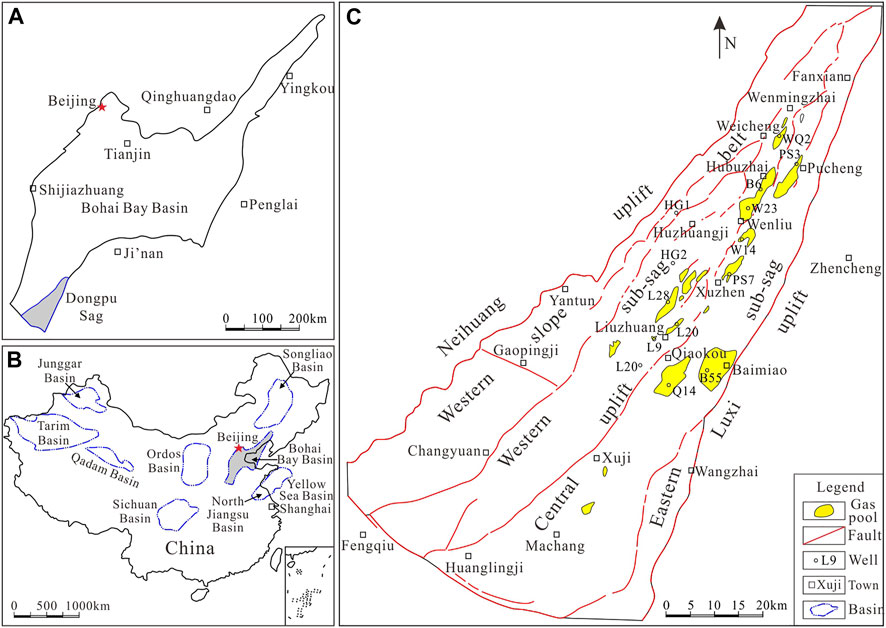
FIGURE 1. The locations of the Dongpu Sag (A) and Bohai Bay Basin (B) and the distribution of gas reservoirs in the Dongpu Sag (C).
The Eocene strata in the Dongpu Sag can be downward divided into Dongying Fm. (E3d), Shahejie Fm. (E2-3s), and Kongdian Fm. (E1k), in which the Shahejie Fm. can be further divided into four members downward (E3s1, E3s2, E2s3, and E2s4) (Figure 2). The underlying Carboniferous-Permian strata include Shiqianfeng Fm. (P2sh), Upper Shihezi Fm. (P2s), Lower Shihezi Fm. (P1x), Shanxi Fm. (P1s), Taiyuan Fm. (C3t), and Benxi Fm. (C2b) (Lyu and Jiang, 2017). Several Eocene tight sandstone gas reservoirs have been discovered in the Wenliu, Qiaokou, and Baimiao areas in the sag (Figure 1), and the Well HG2 in the Huzhuangji area has revealed gas accumulation in the Upper Permian reservoirs. Natural gas in the sag is demonstrated to be derived from two sets of main source rocks, i.e., the Eocene (E3s1 and E2s3) and Upper Paleozoic source rocks (P1s and C3t) (Lyu and Jiang, 2017; Wang et al., 2018; Liu et al., 2017a; Ni et al., 2015).
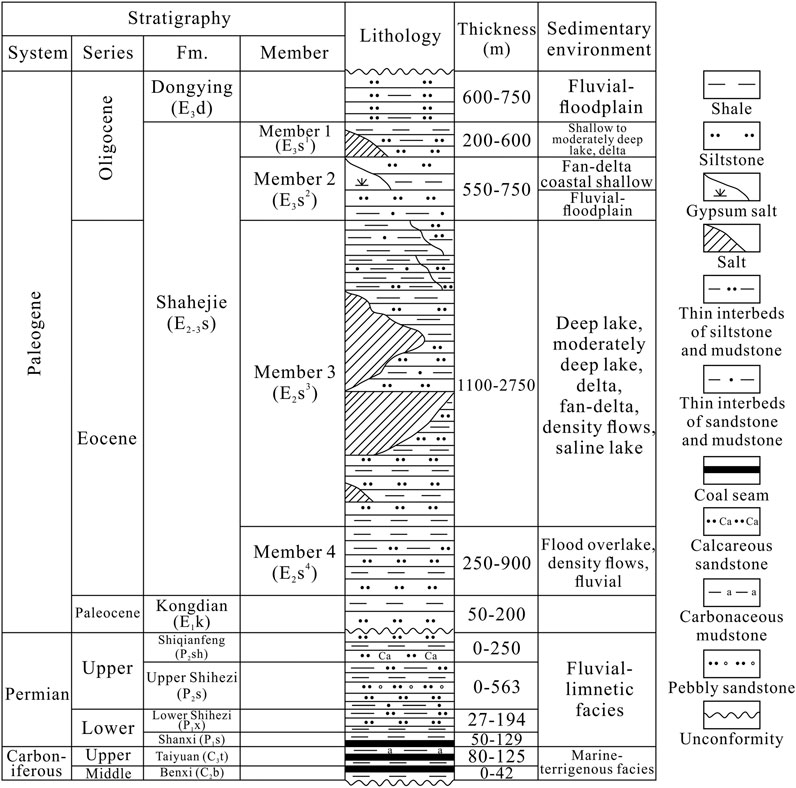
FIGURE 2. Stratigraphic column of the Dongpu Sag, Bohai Bay Basin (Modified after Lyu and Jiang, 2017).
Samples and Analytical Methods
19 gas samples from the E3s2, E2s3, E2s4, and Upper Permian reservoirs in the Dongpu Sag in the Bohai Bay Basin have been collected using stainless steel bottles with double valves. Geochemical analyzes of natural gas have been conducted in the SINOPEC Key Laboratory of Hydrocarbon Accumulation, and chemical compositions of natural gas are analyzed by Varian CP-3800 gas chromatograph. The contents and isotopic ratios of helium and argon are measured by Noblesse noble gas isotope mass spectrometer, and the detailed measuring processes refer to Cao et al. (2018).
Results
The helium and argon concentrations and isotopic ratios of natural gas from the Dongpu Sag in the Bohai Bay Basin are listed in Table 1.
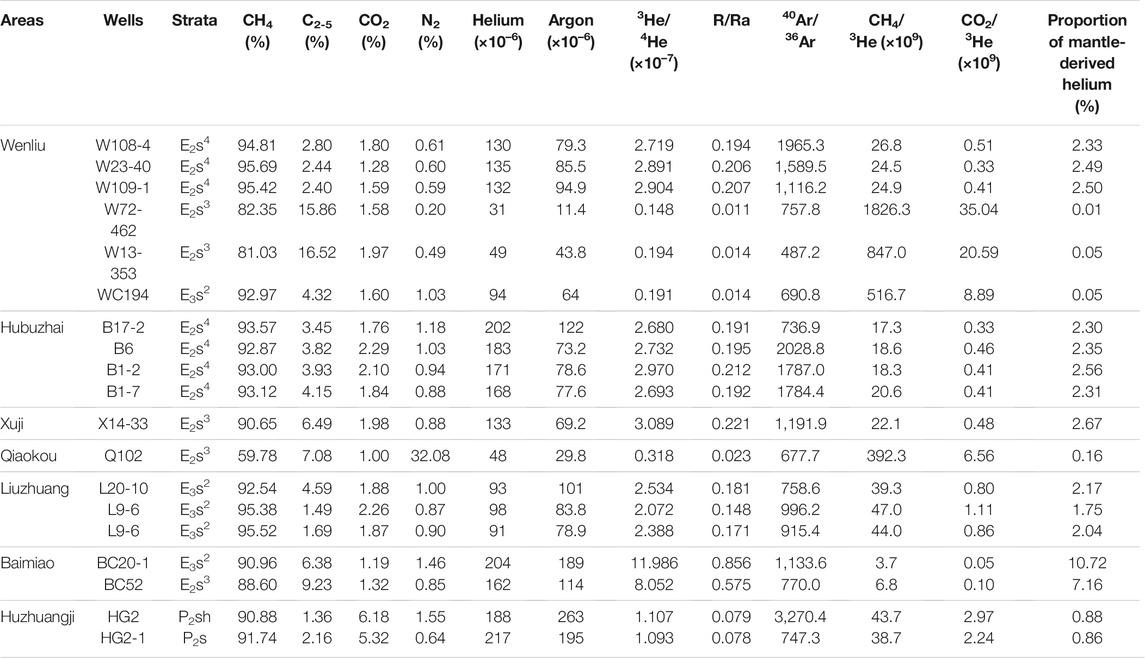
TABLE 1. Helium and argon contents and isotopic compositions of natural gas from the Dongpu Sag, Bohai Bay Basin.
Helium Contents
The E3s2, E2s3, E2s4, and Upper Permian gas samples from the Dongpu Sag display the helium contents of 0.0091–0.0204%, 0.0031–0.0162%, 0.0130–0.0202%, and 0.0188–0.0217%, respectively, with the average contents of 0.0116% (N = 5, N refers to the number of samples), 0.0085% (N = 5), 0.0160% (N = 7), and 0.0202% (N = 2), respectively (Table 1; Figure 3A). Helium contents in natural gas from different strata are lower than 0.05%, which is consistent with the results of other areas in the Bohai Bay Basin according to previous studies (Figure 3B).
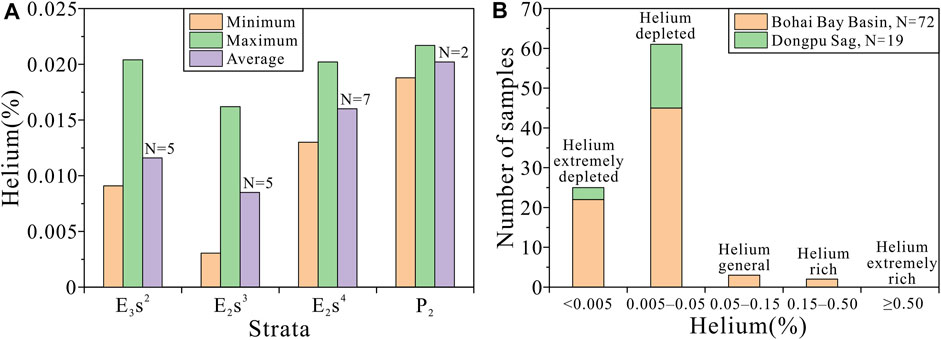
FIGURE 3. Distribution of helium contents in natural gas from different strata in the Dongpu Sag (A) and the comparison with those from the Bohai Bay Basin (B). Data for gas samples in the Bohai Bay Basin are from Zhang et al. (2008) and Dai et al. (2017).
Helium and Argon Isotopic Ratios
The 3He/4He ratios for natural gas from different strata in the Dongpu Sag range from 0.148 × 10–7 to 11.986 × 10–7 (Table 1). The R/Ra values of the E3s2, E2s3, E2s4, and Upper Permian natural gas are 0.014–0.856, 0.011–0.575, 0.191–0.212, and 0.078–0.079, respectively, with the average values of 0.274 (N = 5), 0.169 (N = 5), 0.200 (N = 7), and 0.079 (N = 2), respectively (Table 1). The R/Ra ratios of natural gas from different strata are lower than 1 (Table 1; Figures 4, 5). The 40Ar/36Ar ratios range from 487.2 to 3,270.4 (Table 1), which are significantly higher than that in the air (295.5, Allègre et al., 1987).
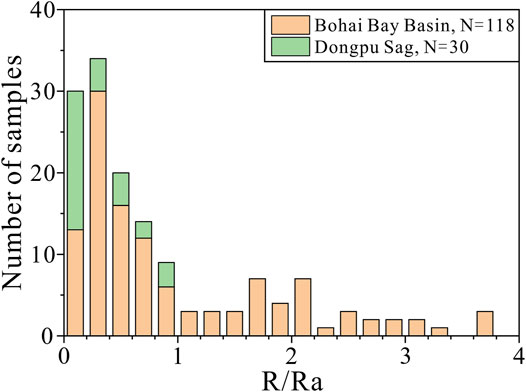
FIGURE 4. Distribution of R/Ra ratios of natural gas from the Dongpu Sag. Data for gas samples in the Bohai Bay Basin are from Zhang et al. (2008) and Dai et al. (2017), and partial data for gas samples from the Dongpu Sag are from Wang et al. (2011).
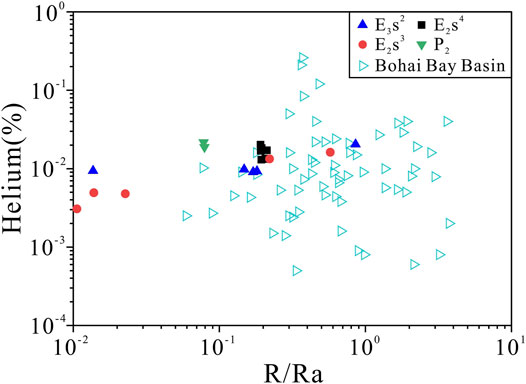
FIGURE 5. Correlation between helium contents and R/Ra ratios of natural gas from the Dongpu Sag. Data for gas samples in the Bohai Bay Basin are from Zhang et al. (2008) and Dai et al. (2017).
CH4/3He and CO2/3He Ratios
The CH4/3He ratios for the E3s2, E2s3, E2s4, and Upper Permian natural gas from the Dongpu Sag are (3.7–516.7) × 109, (6.8–1826.3) × 109, (17.3–26.8) × 109, and (38.7–43.7) × 109, respectively (Table 1), with the average values of 130.1 × 109, 618.9 × 109, 21.6 × 109, and 41.2 × 109, respectively. The corresponding CO2/3He ratios are (0.05–8.89) × 109, (0.10–35.04) × 109, (0.33–0.51) × 109, and (2.24–2.97) × 109, respectively (Table 1), with the average values of 2.34 × 109, 12.56 × 109, 0.41 × 109, and 2.61 × 109, respectively.
Discussion
Helium Abundance in Natural Gas
Natural gas commonly includes five categories according to different helium contents, i.e., extremely depleted (Helium% < 0.005%), helium depleted (0.005% ≤ Helium% < 0.050%), helium general (0.050% ≤ Helium% < 0.150%), helium rich (0.150% ≤ Helium% < 0.500%), and helium extremely rich (Helium% ≥ 0.500%) gases (Dai et al., 2017). The average helium content of natural gas from the Panhandle-Hugoton gas field in the U.S. is 0.586% (Brown, 2019), suggesting the characteristics of helium extremely rich gas. Natural gas from the Weiyuan gas field in the Sichuan Basin in China display the average helium content of 0.251% for 215 gas samples (Dai et al., 2017), and helium contents of natural gas from the Hetianhe gas field in the Tarim Basin range from 0.30% to 0.37% (Tao et al., 2019), both suggesting helium rich gas.
The helium contents of natural gas from the Bohai Bay Basin range from 0.0005% to 0.26% with an average of 0.0197% (Zhang et al., 2008; Dai et al., 2017), which are mainly helium depleted and extremely depleted gases. Among the 72 gas samples from the basin, only 3 and 2 samples reach the standard of helium general and rich gases, respectively (Figure 3B). Natural gas from the Dongpu Sag has the helium contents ranging from 0.0031% to 0.0217% averaging 0.0133%. Natural gas from different strata is helium depleted and extremely depleted rather than helium rich despite various contents of heliumAlthough natural gas from different strata vary in helium contents, the gas is helium depleted and extremely depleted rather than helium rich (Table 1; Figure 3). Helium contents of natural gas from the Dongpu Sag are significantly lower than those from the Sichuan Basin, and this may be derived from the differences of helium source and accumulation mechanism.
Based on the helium amount in the natural gas reserves, helium gas fields can be divided into very small, small, medium, large, and extra large gas fields, with the corresponding helium reserves of <5 × 106 m3, (5–25) × 106 m3, (25–50) × 106 m3, (50–100) × 106 m3, and ≥100 × 106 m3, respectively (Dai et al., 2017). The helium amounts in the Panhandle-Hugoton gas field in the U.S. were about 18,000 × 106 m3 at the time of discovery (Brown, 2019), and the total proved helium reserves in the Hetianhe gas field in the Tarim Basin in China are 195.91 × 106 m3, both being extra large helium gas field. The proved gas reserves in the Dongpu Sag are 138.2 × 109 m3 with the average helium content of 0.0133%. The calculation based on these two parameters indicates that the proved helium reserves in the sag are 18.38 × 106 m3, which suggest a small helium gas field. This indicates that natural gas in the Dongpu Sag displays a low helium abundance with a considerable total amount.
Extraction from helium-bearing natural gas is the only approach to industrially produce helium, and the lower abundance limit for industrially valuable helium reservoirs was commonly believed to be 0.1% (Tao et al., 2019; Chen et al., 2021). Since the boiling point of helium is significantly lower than that of methane, during the process of compressing natural gas to produce liquefied natural gas (LNG) by some countries such as Qatar, helium is relatively enriched in the residual gas which is the by-product of producing LNG (Tao et al., 2019). The required helium contents for helium production by this approach can be as low as 0.04% (Anderson, 2018). 8 of 72 gas samples from the Bohai Bay Basin display the helium contents no less than 0.04% (Zhang et al., 2008; Dai et al., 2017), meeting the required helium abundance to produce helium by LNG. Most gas samples from the Dongpu Sag and other areas in the Bohai Bay Basin display helium contents lower than 0.04%. However, the required helium abundance to produce helium from natural gas may further decrease as the technologies of helium separation and enrichment continuously improve, which makes the effective use of more helium resource possible in the future.
Origin of Helium
Helium in natural gas includes atmospheric, crustal, and mantle-derived helium, in which the typical mantle-derived helium displays the 3He/4He of 1.1 × 10–5 (Xu, 1996; Lupton, 1983) with the R/Ra ratio of 7.9, whereas the R/Ra ratio of typical crustal helium is about 0.01 (Jenden et al., 1993). Helium in natural gas reservoirs in China is mainly composed of crustal and mantle-derived helium (Xu et al., 1995a; Chen et al., 2021). The proportion of mantle-derived helium can be calculated on the basis of a two-endmember (crustal and mantle-derived) mixing model, and the calculation equation is as follows (Jenden et al., 1993).
where R refers to the 3He/4He ratio.
The helium content in natural gas from the Dongpu Sag ranges from 31 × 10–6 to 217 × 10–6 (Table 1), which is significantly higher than that in the atmosphere (5.24 × 10–6, Porcelli et al., 2002). The 40Ar/36Ar ratio ranges from 487.2 to 3,270.4 (Table 1; Figure 6) and is also significantly higher than the atmospheric value (295.5, Allègre et al., 1987). Therefore, natural gas in the Dongpu Sag is unlikely mixed by atmosphere. Calculation based on the R/Ra ratios of natural gas from different strata in the sag (Table 1) and the above-mentioned equation indicates that, the proportion of mantle-derived helium in the gas ranges from 0.01% to 10.72% with an average of 2.39%. The proportions of mantle-derived helium in several samples are less than 1%, suggesting representative characteristics of crustal helium (Table 1).
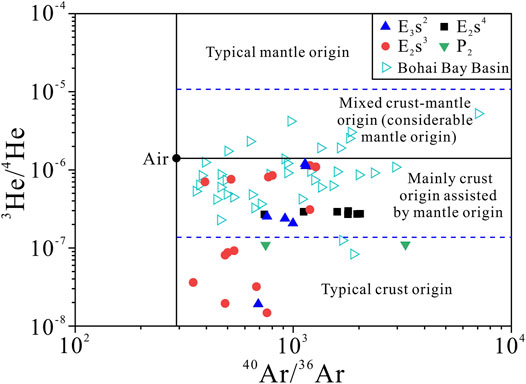
FIGURE 6. Correlation between 3He/4He and 40Ar/36Ar ratios of natural gas from the Dongpu Sag (modified after Li et al., 2017). Data for gas samples in the Bohai Bay Basin are from Zhang et al. (2008) and Dai et al. (2017), and partial data for gas samples from the Dongpu Sag are from Wang et al. (2011).
Helium isotopic compositions have been commonly used to trace mantle-derived volatiles (Poreda et al., 1988; Xu et al., 1997; Oxburgh et al., 1986). R/Ra < 0.1 generally suggests typical crustal source, and 0.1 ≤ R/Ra<1 suggests mixing by a small amount of mantle-derived helium, whereas R/Ra ≥ 1 indicates remarkable addition of mantle-derived helium (Xu et al., 1998; Chen et al., 2021; Li et al., 2017). Natural gas from different strata in the Sichuan Basin displays R/Ra ratios of 0.002–0.05 with an average of 0.015 (Wang et al., 2020), suggesting typical crustal helium (Ni et al., 2014). The R/Ra ratios of natural gas from the Bohai Bay Basin range from 0.059 to 3.74 (Figure 5) with an average of 1.013 (Zhang et al., 2008; Dai et al., 2017), indicating general mixing of mantle-derived helium by various degrees (Figure 6). The R/Ra ratios of natural gas from the Dongpu Sag range from 0.011 to 0.856 (Table 1), displaying the characteristics of mixing between crustal and mantle-derived helium. The R/Ra distribution is consistent with that for gas samples from other areas in the Bohai Bay Basin (Figure 4). In the correlation diagram between 3He/4He and 40Ar/36Ar ratios, 9 of 29 gas samples from the Dongpu Sag are of crustal origin, whereas the other samples are dominated by crustal helium and mixed by a small amount of mantle-derived helium (Figure 6). These are in accordance with the calculation results of the proportion of mantle-derived helium (Table 1).
The alkane gas in the Dongpu Sag is demonstrated to be derived from the organic matters in the E2-3s and C3t-P1s source rocks (Ni et al., 2015; Lyu and Jiang, 2017; Wang et al., 2018), however, the helium is believed to be derived from both the mantle and crustal decay of uranium (U) and thorium (Th) in the rocks. Since the rocks from different strata in the sag contain various contents of U and Th, it needs further study on which strata are the main source of crustal helium.
The Sinian and pre-Sinian gas in southern Sichuan Basin has higher helium abundances than natural gas from other areas of the basin, with the average helium content (0.24%) reaching the standard of commercial exploitation (Ni et al., 2014). The high content of helium in the ancient strata suggests the accumulation of crustal helium with time (Ni et al., 2014), suggesting accumulation effect of helium derived from radioactive decay of U and Th in the rocks. Several gas wells in petroliferous basins in eastern China (e.g., Songliao and North Jiangsu) display the helium contents between 0.05 and 0.1%, and the proportions of mantle-derived helium range from 33.5% to 65.4% (Xu et al., 1997). These indicate that mantle-derived helium in sedimentary strata can form industrial accumulation (Xu et al., 1997). The helium contents and R/Ra ratios of natural gas from the Bohai Bay Basin display little positive correlation (Figure 5). Several gas samples have the helium contents higher than 0.05% with R/Ra ratios around 0.5, whereas the samples with higher R/Ra ratios does not display higher helium contents (Figure 5). This is probably associated with the various original contents of crustal helium in natural gas. Helium contents and R/Ra ratios of natural gas from the Dongpu Sag are positively correlated to some degree. Gas samples with R/Ra < 0.03 have helium contents lower than 0.01%, whereas those with R/Ra > 0.1 have helium contents generally higher than 0.01% (Figure 5). These indicate that the mixing of mantle-derived helium enhanced the helium abundance in natural gas to a certain extent. Moreover, the Upper Permian gas in the Dongpu Sag does not have remarkably higher helium contents than the E2-3s gas (Figure 5), which suggests that the accumulation effect of crustal helium with time is unobvious. The reservoirs in the Sichuan Basin are generally older than those in the Dongpu Sag, and thus the decay time of U and Th in the Sichuan Basin is supposed to be longer than that in the Dongpu Sag. Therefore, natural gas from the Sichuan Basin generally displays higher helium contents than that in the Dongpu Sag.
Since mantle-derived helium in sedimentary strata can form industrial accumulation (Xu et al., 1997), and crustal helium is favorable to be enriched in ancient strata (e.g., Sinian and pre-Sinian strata in southern Sichuan Basin) due to longer decay time of U and Th, helium is likely to accumulate more easily in ancient strata or along the deep faults which connect the mantle.
Correlation of Helium With CH4 and CO2
Helium in natural gas is generally accompanied with alkane gas (e.g., CH4) and CO2, and the association of geochemical characteristics and origin between helium and CH4/CO2 has attracted wide attention (Poreda et al., 1986; Dai et al., 2017; Liu et al., 2016; Liu et al., 2021). The CH4 contents of natural gas from the Dongpu Sag are higher than 80% except one sample of 59.78% (Table 1). The CO2 contents range from 1.0 to 6.18% (Table 1), and both CH4 and CO2 contents have unremarkable correlation with R/Ra ratios (Figures 7A,B). Natural gas from Chinese petroliferous basins display similar characteristics, and only a few gas samples from the North Jiangsu, Songliao, and Bohai Bay basins have experienced mixing by mantle-derived gas with high CO2 contents and R/Ra ratios (Figures 7A,B). Dai et al. (2017) have demonstrated that, natural gas from the cratonic basins in central-western China (e.g., Sichuan and Ordos) has the CO2 contents generally lower than 5%, and the CO2 is considered to be derived from the hydrocarbon generation process and decomposition or erosion of carbonate rocks. Moreover, the gas from the rift basins in eastern China such as Bohai Bay Basin may have higher CO2 content up to nearly 100%, and the CO2 is mainly derived from volcanic-magmatic activities or being mantle-derived (Dai et al., 2017).
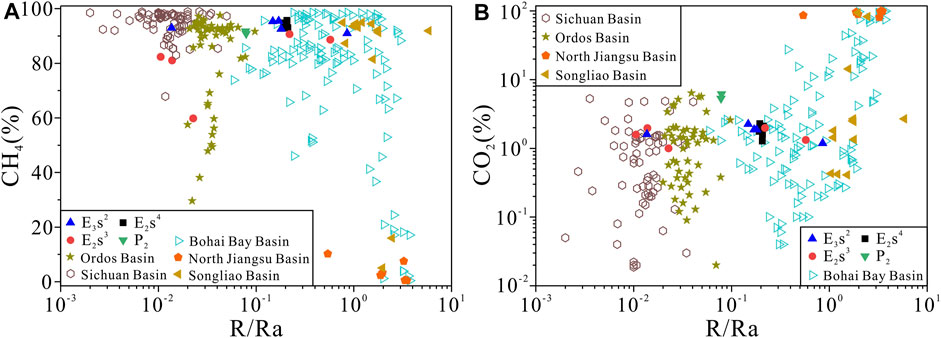
FIGURE 7. Correlation diagrams of CH4(%) versus R/Ra (A) and CO2(%) versus R/Ra (B) of natural gas from the Dongpu Sag. Data for gas samples in the Bohai Bay Basin are from Zhang et al. (2008) and Dai et al. (2017), and those in the Sichuan Basin are from Dai et al. (2008), Ni et al. (2014), and Wu et al. (2013). Data for gas samples from the Ordos, North Jiangsu, and Songliao basins are from Dai et al. (2017), Liu et al. (2017a), and Liu et al. (2016), respectively.
The correlation diagram between CH4/3He and R/Ra ratios are commonly used to constrain natural gas from the crustal or magmatic/mantle source (Poreda et al., 1986; Jenden et al., 1993). Natural gas from cratonic basins in China (e.g., Sichuan, Ordos, and Tarim) is mainly of crustal origin with the CH4/3He ratios of 1010–1012 and R/Ra < 0.1 (Ni et al., 2014; Dai et al., 2017). However, the gas from rift basins (e.g., Bohai Bay and Songliao) displays the addition of mantle-derived components with CH4/3He ratios mainly of 106–1011 and R/Ra > 0.1 (Ni et al., 2014; Dai et al., 2017). The CH4/3He ratios of natural gas from different strata in the Dongpu Sag range from 3.7 × 109 to 1.8263 × 1012 (Table 1), which are mainly consistent with those from other areas in the Bohai Bay Basin and display the characteristics of crust-mantle mixing. The high CH4/3He ratios and low R/Ra ratios for several E3s2 and E2s3 samples are consistent with those for natural gas from cratonic basins such as Sichuan Basin (Figure 8A).
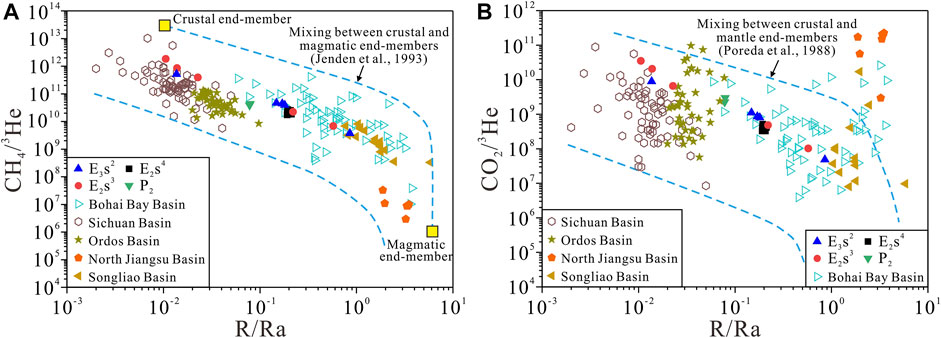
FIGURE 8. Correlation diagrams of CH4/3He versus R/Ra (A) and CO2/3He versus R/Ra (B) of natural gas from the Dongpu Sag. The crustal and magmatic endmembers and crus-mantle mixing line in Figure 7A are from Jenden et al. (1993), whereas the crust-mantle mixing line in Figure 7B is from Poreda et al. (1988). Data for gas samples in the Bohai Bay Basin are from Zhang et al. (2008) and Dai et al. (2017), and those in the Sichuan Basin are from Dai et al. (2008), Ni et al. (2014), and Wu et al. (2013). Data for gas samples from the Ordos, North Jiangsu, and Songliao basins are from Dai et al. (2017), Liu et al. (2017b), and Liu et al. (2016), respectively.
Magmatic/mantle-derived fluids generally have low CO2/3He ratios and high R/Ra ratios, whereas the crustal fluids have high CO2/3He ratios and low R/Ra ratios, and the gas from active continental margins displays a two-endmember mixing trend in the correlation diagram between CO2/3He and R/Ra ratios (Poreda et al., 1988). Natural gas from typical cratonic basins such as Sichuan and Ordos is crustal gas as indicated in the correlation diagram (Wu et al., 2013), whereas the gas from rift basins such as Bohai Bay displays the contribution of mantle-derived fluids (Figure 8B). The CO2/3He ratios of natural gas from the Dongpu Sag range from 0.05 × 109 to 35.04 × 109 (Table 1), which are mainly consistent with those from other areas of the Bohai Bay Basin and display the characteristics of mixing by mantle-derived gas. Several E3s2 and E2s3 samples with relatively high CH4/3He and CO2/3He ratios show similar characteristics with natural gas from cratonic basins such as Sichuan, which display the characteristics of typical crustal gas (Figures 8A,B).
Conclusion
Natural gas from the Dongpu Sag in the Bohai Bay Basin in eastern China has the helium contents of 0.0031%–0.0217% averaging 0.0133%. The 3He/4He, R/Ra, and 40Ar/36Ar ratios are 0.148 × 10−7–11.986 × 10–7, 0.011–0.856, and 487.2–3,270.4, respectively. The CH4/3He and CO2/3He ratios range from 3.7 × 109 to 1.8263 × 1012 and from 0.05 × 109 to 35.04 × 109, respectively.
The gas from the Dongpu Sag is helium depleted and extremely depleted, and the calculated helium amounts in the proved gas reserves are 18.38 × 106 m3, suggesting a small helium gas field. Although the helium abundance is relatively low, the total amount of helium is considerable. The effective use of these helium resource may be probable with the continuous improvement of the technologies of helium separation and enrichment.
Helium in natural gas from the Dongpu Sag is mainly crustal and mixed by a small amount of mantle-derived helium, and the proportion of mantle-derived helium ranges from 0.01% to 10.72% averaging 2.39%. The isotopic compositions associated with helium indicate that, natural gas from the Dongpu Sag is mainly derived from mixing between crustal and mantle sources, which is in accordance with the gas from other areas of the Bohai Bay Basin. Several gas samples from members 2 and 3 of the Shahejie Fm. display unremarkable mixing by mantle-derived helium, and their characteristics are consistent with those of natural gas from cratonic basins in China.
Data Availability Statement
The original contributions presented in the study are included in the article/Supplementary Material, further inquiries can be directed to the corresponding author.
Author Contributions
CN: Conceptulization, Data curation, Writing. XW: Data curation, Writing. QL: Conceptulization, Writing. DZ: Data curation, Methodology. FY: Methodology, Investigation. QM: Investigation. HX: Methodology. SX: Investigation. TX: Investigation.
Funding
This work was funded by National Natural Science Foundation of China (Grant Nos: 42141021, 42172149, 41872122, U20B6001) and Strategic Priority Research Program of the Chinese Academy of Sciences (Class A) (Grant No. XDA14010404).
Conflict of Interest
Authors CN, XW, QL, DZ, FY, QM, HX, SX and TX were employed by SINOPEC.
Publisher’s Note
All claims expressed in this article are solely those of the authors and do not necessarily represent those of their affiliated organizations, or those of the publisher, the editors and the reviewers. Any product that may be evaluated in this article, or claim that may be made by its manufacturer, is not guaranteed or endorsed by the publisher.
Acknowledgments
The authors appreciate the SINOPEC Zhongyuan Branch Company for the assistance on sample and data collection. The SINOPEC Key Laboratory of Hydrocarbon Accumulation is acknowledged for the assistance on geochemical analyzes. We sincerely appreciate the constructive comments and suggestions proposed by the reviewers.
References
Allègre, C. J., Staudacher, T., and Sarda, P. (1987). Rare Gas Systematics: Formation of the Atmosphere, Evolution and Structure of the Earth's Mantle. Earth Planet. Sci. Lett. 81 (2), 127–150. doi:10.1016/0012-821x(87)90151-8
Anderson, S. T. (2018). Economics, Helium, and the U.S. Federal Helium Reserve: Summary and Outlook. Nat. Resour. Res. 27 (4), 455–477. doi:10.1007/s11053-017-9359-y
Brown, A. (2019). Origin of Helium and Nitrogen in the Panhandle-Hugoton Field of Texas, Oklahoma, and Kansas, United States. AAPG Bulletin 103, 369–403. doi:10.1306/07111817343
Cao, C., Zhang, M., Tang, Q., Yang, Y., Lv, Z., Zhang, T., et al. (2018). Noble Gas Isotopic Variations and Geological Implication of Longmaxi Shale Gas in Sichuan Basin, China. Mar. Pet. Geology. 89, 38–46. doi:10.1016/j.marpetgeo.2017.01.022
Cao, C., Zhang, M., Li, L., Wang, Y., Li, Z., Du, L., et al. (2020). Tracing the Sources and Evolution Processes of Shale Gas by Coupling Stable (C, H) and noble Gas Isotopic Compositions: Cases from Weiyuan and Changning in Sichuan Basin, China. J. Nat. Gas Sci. Eng. 78, 103304. doi:10.1016/j.jngse.2020.103304
Chang, J., Li, X., He, J., Lv, H., Zhang, T., and Huang, Y. (2005). Researches on Characteristics of Geochemistry and Formation of Wengu 2 Well Natural Gas in Dongpu Depression. Nat. Gas Geosci. 16 (5), 608–611. doi:10.11764/j.issn.1672-1926.2005.05.608
Chen, J., Liu, K., Dong, Q., Wang, H., Luo, B., and Dai, X. (2021). Research Status of Helium Resources in Natural Gas and Prospects of Helium Resources in China. Nat. Gas Geosci. 32 (10), 1436–1449. doi:10.11764/j.issn.1672-1926.2021.08.006
Dai, J., Zou, C., Zhang, S., Li, J., Ni, Y., Hu, G., et al. (2008). Discrimination of Abiogenic and Biogenic Alkane Gases. Sci. China Ser. D-earth Sci. 51, 1737–1749. doi:10.1007/s11430-008-0133-1
Dai, J., Ni, Y., Qin, S., Huang, S., Gong, D., Liu, D., et al. (2017). Geochemical Characteristics of He and CO2 from the Ordos (Cratonic) and Bohaibay (Rift) Basins in China. Chem. Geology. 469, 192–213. doi:10.1016/j.chemgeo.2017.02.011
Ding, W., Dai, J., Yang, C., Tao, S., and Hou, L. (2005). Helium Isotopic Compositions in Fluid Inclusions of the Gangxi Fault belt in the Huanghua Depression, Bohai Bay Basin. Chin. Sci. Bull. 50, 2621–2627. doi:10.1007/bf03183660
Gong, D., Li, J., Ablimit, I., He, W., Lu, S., Liu, D., et al. (2018). Geochemical Characteristics of Natural Gases Related to Late Paleozoic Coal Measures in China. Mar. Pet. Geology. 96, 474–500. doi:10.1016/j.marpetgeo.2018.06.017
Gong, D., Song, Y., Wei, Y., Liu, C., Wu, Y., Zhang, L., et al. (2019). Geochemical Characteristics of Carboniferous Coaly Source Rocks and Natural Gases in the Southeastern Junggar Basin, NW China: Implications for New Hydrocarbon Explorations. Int. J. Coal Geology. 202, 171–189. doi:10.1016/j.coal.2018.12.006
Jenden, P. D., Hilton, D. R., Kaplan, I. R., and Craig, H. (1993). “Abiogenic Hydrocarbons and Mantle Helium in Oil and Gas fields,” in The Future of Energy Gases. Editor D. G. Howell (Denver: U.S. Geological Survey Professional Paper), 31–56.
Jiao, D., Wang, D., and Wu, X. (2006). Patterns of Natural Gas Accumulation and Enrichment in Dongpu Depression. Oil Gas Geology. 27 (6), 794–803. doi:10.11743/ogg20060610
Li, C., and Chen, F. (2015). Origin of the Natural Gas from Paleogene Shahejie Formation in the Qiaokou-Baimiao Areas of the Dongpu Depression, Bohai Bay Basin. Nat. Gas Geosci. 26 (11), 2114–2121. doi:10.11764/j.issn.1672-1926.2015.11.2114
Li, J., Li, Z., Wang, X., Wang, D., Xie, Z., Li, J., et al. (2017). New Indexes and Charts for Genesis Identification of Multiple Natural Gases. Pet. Exploration Dev. 44, 535–543. doi:10.1016/s1876-3804(17)30062-9
Liu, Q., Dai, J., Jin, Z., Li, J., Wu, X., Meng, Q., et al. (2016). Abnormal Carbon and Hydrogen Isotopes of Alkane Gases from the Qingshen Gas Field, Songliao Basin, China, Suggesting Abiogenic Alkanes. J. Asian Earth Sci. 115, 285–297. doi:10.1016/j.jseaes.2015.10.005
Liu, J., Jiang, Y., Zhang, Y., Xu, T., Mu, X., and Wan, T. (2017a). Genesis and Charge Difference of Paleogene Tight sandstone Gas in Dongpu Sag. Acta Petrolei Sinica 38 (9), 1010–1020. doi:10.7623/syxb201709003
Liu, Q., Zhu, D., Jin, Z., Meng, Q., Wu, X., and Yu, H. (2017b). Effects of Deep CO2 on Petroleum and thermal Alteration: The Case of the Huangqiao Oil and Gas Field. Chem. Geology. 469, 214–229. doi:10.1016/j.chemgeo.2017.06.031
Liu, Q., Wu, X., Wang, X., Jin, Z., Zhu, D., Meng, Q., et al. (2019). Carbon and Hydrogen Isotopes of Methane, Ethane, and Propane: A Review of Genetic Identification of Natural Gas. Earth-Science Rev. 190, 247–272. doi:10.1016/j.earscirev.2018.11.017
Liu, Q., Wu, X., Zhu, D., Meng, Q., Xu, H., Peng, W., et al. (2021). Generation and Resource Potential of Abiogenic Alkane Gas under Organic-Inorganic Interactions in Petroliferous Basins. J. Nat. Gas Geosci. 6 (2), 79–87. doi:10.1016/j.jnggs.2021.04.003
Lupton, J. E. (1983). Terrestrial Inert Gases: Isotope Tracer Studies and Clues to Primordial Components in the Mantle. Annu. Rev. Earth Planet. Sci. 11, 371–414. doi:10.1146/annurev.ea.11.050183.002103
Lyu, X., and Jiang, Y. (2017). Genesis of Paleogene Gas in the Dongpu Depression, Bohai Bay Basin, East China. J. Pet. Sci. Eng. 156, 181–193. doi:10.1016/j.petrol.2017.05.021
Mamyrin, B. A., Anufrier, G. S., Kamensky, I. L., and Tolstikhin, I. N. (1970). Determination of the Isotopic Composition of Helium in the Atmosphere. Geochem. Int. 7, 498–505.
Marty, B., Jambon, A., and Sano, Y. (1989). Helium Isotopes and CO2 in Volcanic Gases of Japan. Chem. Geology. 76, 25–40. doi:10.1016/0009-2541(89)90125-3
Ni, Y., Dai, J., Tao, S., Wu, X., Liao, F., Wu, W., et al. (2014). Helium Signatures of Gases from the Sichuan Basin, China. Org. Geochem. 74, 33–43. doi:10.1016/j.orggeochem.2014.03.007
Ni, C., Bao, J., Zhou, X., Xu, S., Xu, L., Xu, T., et al. (2015). Geochemical Characteristics and Types of Natural Gas from Well Hugu 2 in the Dongpu Sag of Bohai Bay Basin. Pet. Geology. Exp. 37 (6), 764–769 775. doi:10.11781/sysydz201506764
Oxburgh, E. R., O'Nions, R. K., and Hill, R. I. (1986). Helium Isotopes in Sedimentary Basins. Nature 324, 632–635. doi:10.1038/324632a0
Peng, W., Liu, Q., Zhang, Y., Jia, H., Zhu, D., Meng, Q., et al. (2022). The First Extra-large Helium-Rich Gas Field Identified in a Tight sandstone of the Dongsheng Gas Field, Ordos Basin, central China. Sci. China Earth Sci. (in press). doi:10.1360/SSTe-2021-0277
Polyak, B. G., Tolstikhin, I. N., Kamensky, I. L., Yakovlev, L. E., Cheshko, A. L., and Marty, B. (2000). Helium Isotopes, Tectonics and Heat Flow in the Northern Caucasus. Geochimica et Cosmochimica Acta 64, 1925–1944. doi:10.1016/s0016-7037(00)00342-2
Porcelli, D., Ballentine, C. J., and Wieler, R. (2002). An Overview of Noble Gas Geochemistry and Cosmochemistry. Rev. Mineralogy Geochem. 47, 1–19. doi:10.2138/rmg.2002.47.1
Poreda, R. J., Jenden, P. D., Kaplan, I. R., and Craig, H. (1986). Mantle Helium in Sacramento basin Natural Gas wells. Geochimica et Cosmochimica Acta 50, 2847–2853. doi:10.1016/0016-7037(86)90231-0
Poreda, R. J., Jeffrey, A. W. A., Kaplan, I. R., and Craig, H. (1988). Magmatic Helium in Subduction-Zone Natural Gases. Chem. Geology. 71, 199–210. doi:10.1016/0009-2541(88)90115-5
Tao, X., Li, J., Zhao, L., Li, L., Zhu, W., Xing, L., et al. (2019). Helium Resources and Discovery of First Supergiant Helium reserve in China: Hetianhe Gas Field. Earth Sci. 44, 1024–1041. doi:10.3799/dqkx.2018.381
Wang, S., Liu, H., Dong, H., Liu, J., Zhu, L., and Xu, B. (2011). Distribution and Origin of Natural Gas in Qiaokou-Baimiao Area, Dongpu Depression. Fautl-Block Oil & Gas Field 18 (2), 207–211.
Wang, K., Pang, X., Zhang, H., Zhao, Z., Su, S., and Hui, S. (2018). Characteristics and Genetic Types of Natural Gas in the Northern Dongpu Depression, Bohai Bay Basin, China. J. Pet. Sci. Eng. 170, 453–466. doi:10.1016/j.petrol.2018.06.080
Wang, X., Liu, W., Li, X., Liu, Q., Tao, C., and Xu, Y. (2020). Radiogenic Helium Concentration and Isotope Variations in Crustal Gas Pools from Sichuan Basin, China. Appl. Geochem. 117, 104586. doi:10.1016/j.apgeochem.2020.104586
Wu, X., Dai, J., Liao, F., and Huang, S. (2013). Origin and Source of CO2 in Natural Gas from the Eastern Sichuan Basin. Sci. China Earth Sci. 56, 1308–1317. doi:10.1007/s11430-013-4601-x
Wu, X., Ni, C., Liu, Q., Liu, G., Zhu, J., and Chen, Y. (2017). Genetic Types and Source of the Upper Paleozoic Tight Gas in the Hangjinqi Area, Northern Ordos Basin, China. Geofluids 2017, 1–14. doi:10.1155/2017/4596273
Xu, S., Nakai, S. i., Wakita, H., Xu, Y., and Wang, X. (1995a). Helium Isotope Compositions in Sedimentary Basins in China. Appl. Geochem. 10, 643–656. doi:10.1016/0883-2927(95)00033-x
Xu, S., Nakai, S. i., Wakita, H., and Wang, X. (1995b). Mantle-derived noble Gases in Natural Gases from Songliao Basin, China. Geochimica et Cosmochimica Acta 59, 4675–4683. doi:10.1016/0016-7037(95)00301-0
Xu, Y., Shen, P., Tao, M., and Liu, W. (1997). Geochemistry on Mantle-Derived Volatiles in Natural Gases from Eastern China Oil/gas Provinces (I). Sci. China Ser. D-earth Sci. 40, 120–129. doi:10.1007/bf02878370
Xu, Y., Shen, P., Liu, W., Tao, M., Sun, M., and Du, J. (1998). Geochemistry of noble Gases in Natural Gas. Beijing: Science Press.
Xu, Y. (1996). The Mantle noble Gas of Natural Gases. Earth Sci. Front. 3, 63–71. doi:10.3321/j.issn:1005-2321.1996.03.006
Zhang, T., Zhang, M., Bai, B., Wang, X., and Li, L. (2008). Origin and Accumulation of Carbon Dioxide in the Huanghua Depression, Bohai Bay Basin, China. Bulletin 92, 341–358. doi:10.1306/10230706141
Zhang, W., Li, Y., Zhao, F., Han, W., Li, Y., Wang, Y., et al. (2019). Using noble Gases to Trace Groundwater Evolution and Assess Helium Accumulation in Weihe Basin, central China. Geochimica et Cosmochimica Acta 251, 229–246. doi:10.1016/j.gca.2019.02.024
Keywords: Dongpu Sag, helium content, helium isotopic compositions, argon isotopic ratios, Bohai Bay basin
Citation: Ni C, Wu X, Liu Q, Zhu D, Yang F, Meng Q, Xu H, Xu S and Xu T (2022) Helium Signatures of Natural Gas From the Dongpu Sag, Bohai Bay Basin, Eastern China. Front. Earth Sci. 10:862677. doi: 10.3389/feart.2022.862677
Received: 26 January 2022; Accepted: 10 February 2022;
Published: 24 February 2022.
Edited by:
Deyu Gong, Research Institute of Petroleum Exploration and Development (RIPED), ChinaReviewed by:
Hao Zou, Chengdu University of Technology, ChinaShu Tao, China University of Geosciences, China
Copyright © 2022 Ni, Wu, Liu, Zhu, Yang, Meng, Xu, Xu and Xu. This is an open-access article distributed under the terms of the Creative Commons Attribution License (CC BY). The use, distribution or reproduction in other forums is permitted, provided the original author(s) and the copyright owner(s) are credited and that the original publication in this journal is cited, in accordance with accepted academic practice. No use, distribution or reproduction is permitted which does not comply with these terms.
*Correspondence: Quanyou Liu, cXlvdWxpdUBzb2h1LmNvbQ==
 Chunhua Ni1,2
Chunhua Ni1,2 Xiaoqi Wu
Xiaoqi Wu Quanyou Liu
Quanyou Liu Qingqiang Meng
Qingqiang Meng Huiyuan Xu
Huiyuan Xu